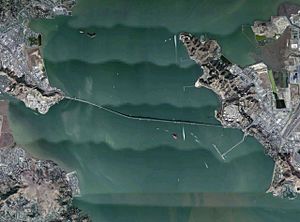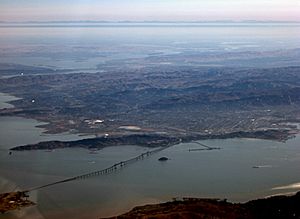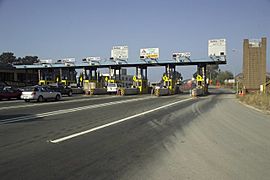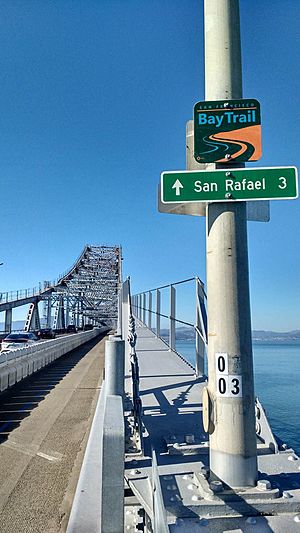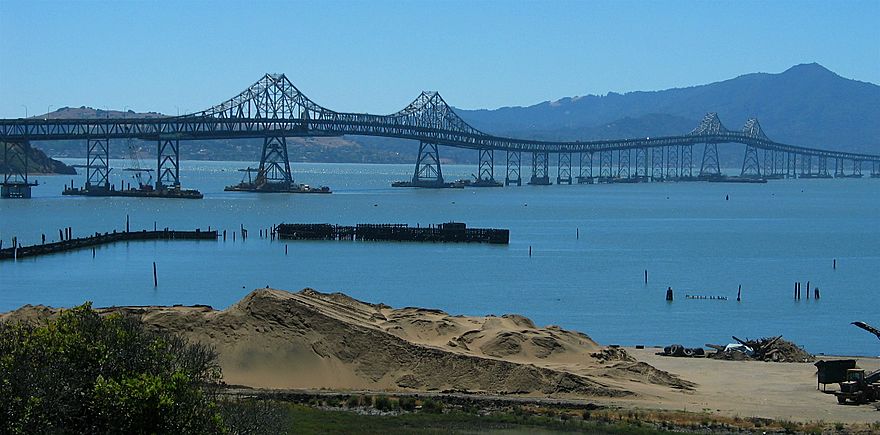Richmond–San Rafael Bridge facts for kids
Quick facts for kids Richmond–San Rafael Bridge |
|
|---|---|
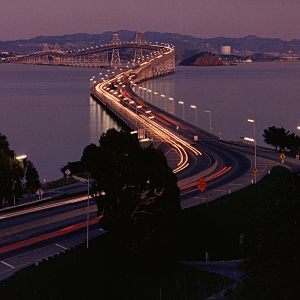
The Richmond–San Rafael Bridge from its western terminus
|
|
| Coordinates | 37°56′05″N 122°26′02″W / 37.9347°N 122.4338°W |
| Carries | 5 lanes (2 WB on upper level, 2-3 EB on lower) of |
| Crosses | San Francisco Bay and San Pablo Bay |
| Locale | San Rafael, California and Richmond, California |
| Official name | Richmond–San Rafael Bridge or John F. McCarthy Memorial Bridge |
| Other name(s) | Richmond Bridge San Rafael Bridge |
| Named for | John F. McCarthy |
| Owner | State of California |
| Maintained by | California Department of Transportation and the Bay Area Toll Authority |
| ID number | 28 0100 |
| Characteristics | |
| Design | Double-Decked Dual Cantilever bridge with Pratt Truss Approach |
| Total length | 29,040 ft (5.500 mi; 8.85 km) |
| Longest span | 1,070 feet (330 m) cantilever structure |
| Number of spans | 77 in total, consisting of: 19 girder spans (west) |
| Piers in water | 70 |
| Clearance below | 185 feet (56 m) (main channel) 135 feet (41 m) (secondary channel) |
| History | |
| Designer | Norman Raab |
| Constructed by | Gerwick—Kiewit Joint Venture (substructure) Kiewit—Soda—Judson Pacific-Murphy Joint Venture (superstructure) |
| Construction begin | March 1953 |
| Construction cost | US$62,000,000 (equivalent to $667,400,000 in 2022) |
| Opened | September 1, 1956 |
| Statistics | |
| Daily traffic | 66,800 (2011) 67,800 (2012) |
| Toll | Cars (westbound only) $6.00 (cash or FasTrak), $3.00 (carpools during peak hours, FasTrak only) |
The Richmond–San Rafael Bridge (also officially named the John F. McCarthy Memorial Bridge) is the northernmost of the east–west crossings of the San Francisco Bay in California, USA. Officially named after California State Senator John F. McCarthy, it bridges Interstate 580 from Richmond on the east to San Rafael on the west. It opened in 1956, replacing ferry service by the Richmond–San Rafael Ferry Company.
Contents
History
Early proposals
Proposals for a bridge were advanced in the 1920s, preceding the completion of the Golden Gate Bridge. In 1927, Roy O. Long of The Richmond–San Rafael Bridge, Incorporated, applied for a franchise to construct and operate a private toll bridge. The proposed 1927 Long bridge would have been a steel suspension bridge, carrying a 30-foot-wide (9.1 m) roadway for a distance of 14,600 feet (4,500 m) at an estimated construction cost of US$12,000,000 (equivalent to $202,200,000 in 2022). The bridge would afford a maximum vertical clearance of 135 feet (41 m) with a 1,200-foot (370 m) main span.
A competing proposed bridge also came out in 1927, from Charles Van Damme of the Richmond-San Rafael Ferry Company. The 1927 Van Damme bridge would have carried a 27-foot-wide (8.2 m) roadway for a distance of 19,000 feet (5,800 m) at an identical estimated construction cost of US$12,000,000 (equivalent to $202,200,000 in 2022).
Van Damme and Long later agreed in September 1928 to merge their interests for a combined bridge proposal between Point San Pablo (Contra Costa County) and McNear's Point (Marin County).
Klatt's 1929 bridge was dormant for nearly a decade following the issuance of a construction permit in 1930. An extension was filed in 1938 to allow construction to start as late as February 1942,
Tomasini's San Francisco–Alameda–Marin crossings
A third bridge was proposed in late 1927 by the enigmatic T.A. Tomasini. Tomasini's 1927 bridge called for two lanes of automobile traffic straddling a central rail line from San Pedro Hill (Marin) to San Pablo station (Contra Costa), a distance of over 5 miles (8.0 km).
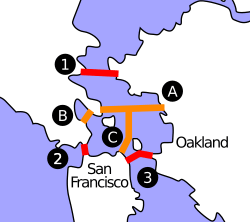
- Albany–Tiburon bridge
- Sausalito–Belvedere bridge
- San Francisco–Marin–Alameda tunnel & bridge
Tomasini would later add a bridge spanning Richardson Bay in March 1928 from Sausalito to Belvedere to his proposal. The additional Sausalito–Belvedere bridge would have been 7,300 feet (2,200 m) long and 22 feet (6.7 m) wide with a lift span to allow the passage of large vessels, at an estimated cost of US$750,000 (equivalent to $12,800,000 in 2022). The Redwood Bridge carried the Redwood Highway (present-day US 101) and spanned the upper reach of Richardson Bay, eliminating some of the need for the proposed Sausalito–Belvedere bridge. The Redwood Bridge would be replaced by a concrete structure in the 1950s.
Tomasini continued to add to the project scope in July 1928 by proposing a bridge and tunnel to join San Francisco to the proposed Albany–Tiburon bridge. The tunnel would run roughly northeast from Bay Street and Grant Avenue, not far from present-day Pier 39, at a depth of 50 feet (15 m) below low tide water level for 11,200 feet (3,400 m). At that point, the tunnel would surface northwest of Goat Island, and then transition to a bridge nearly 4 miles (6.4 km) long with a minimum vertical clearance of 50 feet (15 m) and two lift spans connecting to the proposed Albany–Tiburon bridge. The cost of the entire project was US$55,670,000 (equivalent to $948,800,000 in 2022), split as US$20,000,000 (equivalent to $340,900,000 in 2022) for the Albany–Tiburon bridge, US$670,000 (equivalent to $11,400,000 in 2022) for the Sausalito–Belvedere bridge, and US$35,000,000 (equivalent to $596,500,000 in 2022) for the San Francisco–Marin–Alameda tunnel and bridge.
By February 1932, Tomasini's proposed Albany–Tiburon bridge had changed to a combination bridge—tunnel. The bridge portion was a low trestle approximately 19,800 feet (6,000 m) long, extending westward from Point Fleming in Albany in Alameda County. The proposed tunnel would have been 17,200 feet (5,200 m) long and ventilated by four towers, emerging at Bluff Point near Tiburon in Marin County.
Construction: 1953–1956
In 1949, the County of Marin and the City of Richmond commissioned a preliminary engineering report from Earl and Wright of San Francisco, which concluded that a bridge would be feasible. A follow-up 1950 study, conducted by the Division of San Francisco Bay Toll Crossings, was commissioned by Marin County and the City of Richmond using US$200,000 (equivalent to $2,430,000 in 2022) in state funding. The 1950 report concluded the bridge could be built in accordance with the California Toll Bridge Authority Act. The preliminary design was approved on 1951-08-08 and California approved the preliminary report on 1951-11-27. The California Toll Bridge Authority authorized the issue of US$72,000,000 (equivalent to $793,400,000 in 2022) in bonds on 1952-11-07 and subsequently sold US$62,000,000 (equivalent to $678,100,000 in 2022) on 1953-02-26 to construct a single-deck bridge. The remaining US$10,000,000 (equivalent to $109,400,000 in 2022) was reserved for construction contingencies and to complete the lower deck of the bridge. The $62 million raised from bond sales was divided into three parts: US$50,000,000 (equivalent to $546,900,000 in 2022) for construction, US$10,000,000 (equivalent to $109,400,000 in 2022) to address interest obligations on the bonds during the construction period, and US$2,000,000 (equivalent to $21,900,000 in 2022) in construction contingency. In 1954, Governor Knight declared the second deck should not be delayed in the public interest, and US$6,000,000 (equivalent to $65,500,000 in 2022) was loaned from the State School Land Fund in 1955 to complete the second deck. The bridge was finished $4 million under budget.
During the study period, an earth and rock-fill bridge with lift structures was considered, but the high-level bridge was chosen as the cost of a low bridge with navigation locks and lifting structures was prohibitive.
The majority of construction costs were tied up in two contracts that opened for bidding on 1952-12-19. The first contract, for the substructure, was awarded to the low bidder, the Ben C. Gerwick, Inc. — Peter Kiewit Sons' Co. Joint Venture for US$14,234,550 (equivalent to $155,700,000 in 2022). The second contract, for the superstructure, was awarded to the low bid of US$21,099,319 (equivalent to $230,800,000 in 2022) by a joint venture between Peter Kiewit Sons' Co. — A. Soda & Son — Judson Pacific Murphy Corp. The substructure construction moved rapidly, with an estimated 45% of piers completed approximately a year after the contract was awarded.
At the time the bridge was completed, it was hailed as the world's second-longest bridge, behind the San Francisco–Oakland Bay Bridge
Public transit service
Golden Gate Transit bus routes 40 and 580 provide public transportation across the bridge. Route 40 runs between the San Rafael Transit Center and the El Cerrito del Norte BART station.
Tolls
Tolls are only collected from westbound traffic headed to San Rafael at the toll plaza on the east side of the bridge. Since January 2019, the toll rate for (two axle) passenger cars and motorcycles is $6. During peak traffic hours, high-occupancy vehicles (defined as two-axle vehicles without trailers, carrying three or more people; two-axle vehicles designed with two passenger seats without trailers, carrying two people; or motorcycles) pay a discounted toll of $3. Since January 1, 2019, for vehicles with more than two axles, the toll rate is $16 for 3 axles and $5 per each additional axle over 3, up to a maximum toll of $36 for vehicles with seven or more axles. Drivers may either pay by cash or use the FasTrak electronic toll collection device.
Historical toll rates
The following initial toll rates were adopted on July 10, 1956 prior to the opening of the bridge:
| Vehicle type | Axles/trailers | Toll |
|---|---|---|
| Class 1 | vehicle alone | US$0.75 (equivalent to $8.07 in 2022) |
| Commutation book | US$18.75 (equivalent to $201.82 in 2022) | |
| with 1-axle trailer | US$1.25 (equivalent to $13.45 in 2022) | |
| with 2-axle trailer | US$1.50 (equivalent to $16.15 in 2022) | |
| Truck | 2-axle | US$1.25 (equivalent to $13.45 in 2022) |
| 3-axle | US$1.75 (equivalent to $18.84 in 2022) | |
| 4-axle | US$2.50 (equivalent to $26.91 in 2022) | |
| 5-axle | US$3.00 (equivalent to $32.29 in 2022) | |
| 6-axle | US$3.50 (equivalent to $37.67 in 2022) | |
| 7-axle | US$4.00 (equivalent to $43.06 in 2022) | |
| Bus | 2-axle | US$1.50 (equivalent to $16.15 in 2022) |
| 3-axle | US$1.75 (equivalent to $18.84 in 2022) | |
| Other vehicles not specified above | US$5.00 (equivalent to $53.82 in 2022) | |
| Inaugural toll table notes | ||
The basic toll (for automobiles) on the seven state bridges, including the Richmond–San Rafael Bridge, was raised to $1 by Regional Measure 1, approved by Bay Area voters in 1988. A $1 seismic retrofit surcharge was added in 1998 by the state legislature, originally for eight years, but since then extended to December 2037 (AB1171, October 2001). On March 2, 2004, voters approved Regional Measure 2, raising the toll by another dollar to a total of $3. An additional dollar was added to the toll starting January 1, 2007, to cover cost overruns concerning the replacement of the eastern span.
The Metropolitan Transportation Commission, a regional transportation agency, in its capacity as the Bay Area Toll Authority, administers RM1 and RM2 funds, allocating a significant portion to public transit capital improvements and operating subsidies in the transportation corridors the bridges serve. Caltrans administers the "second dollar" seismic surcharge, and receives some of the MTC-administered funds to perform other maintenance work on the bridges. The Bay Area Toll Authority is made up of appointed officials put in place by various city and county governments, and is not subject to direct voter oversight.
Due to further funding shortages for seismic retrofit projects, the Bay Area Toll Authority again raised tolls on all seven of the state-owned bridges in July 2010. The toll rate for autos on the Richmond–San Rafael Bridge was thus increased to $5.
In June 2018, Bay Area voters approved Regional Measure 3 to further raise the tolls on all seven of the state-owned bridges to fund $4.5 billion worth of transportation improvements in the area. Under the passed measure, the toll rate for autos on the Richmond–San Rafael Bridge will be increased to $6 on January 1, 2019; to $7 on January 1, 2022; and then to $8 on January 1, 2025.
In September 2019, the MTC approved a $4 million plan to eliminate toll takers and convert all seven of the state-owned bridges to all-electronic tolling, citing that 80 percent of drivers are now using Fastrak and the change would improve traffic flow. On March 20, 2020, at midnight, due to the COVID-19 pandemic, all-electronic tolling was temporarily placed in effect for all seven state-owned toll bridges, and as of December 10, 2020, all of the state-owned toll bridges are now permanently cashless.
Improvements
Seismic retrofit
In the fall of 2001, the bridge commenced an extensive seismic retrofit program,
The fifty-year-old bridge was showing its age and also needed age-related maintenance, which was performed in conjunction with the seismic upgrade work. There were reports of cars being damaged while traveling on the lower deck by fist-sized concrete chunks falling from the joints of upper deck slabs.
A major part of the retrofit involved the long concrete causeway on the Marin side, which as part of the retrofit program, was nearly completely replaced. Because of the active use of the bridge, Caltrans designed the project to allow the bridge to remain open to traffic. For economy, schedule efficiency and traffic impact mitigation, much of the repair work was fabricated off site and shipped to the bridge by barge.
To reduce impacts to traffic the major work was performed at night. Caltrans kept two lanes of traffic moving in each direction during daylight hours, then reduced that flow to a single lane in each direction at night. Thus, one trestle was completely closed, and the other trestle had two-way traffic.
The concrete segments of the trestle were precast in Petaluma and barged to the site. At monthly intervals, tugs positioned barges with one or two 100-foot-long (30 m), 500-ton pre-cast concrete roadway segments, which a 900-ton barge-mounted crane lifted into place. Earlier, either two or four of the corroded, 50-foot (15 m) concrete segments of the old roadway were removed by crane. Then, a pile driver moved into position and drove new piles. After the new concrete road segment was in place, steel plates were used to temporarily fill the gaps, and the roadway was ready for morning traffic. At times, construction backed up traffic to Highway 101 into central San Rafael.
The completion of this retrofit, on September 22, 2005 was celebrated as a success despite the many challenges, including the deaths of two workers.
The retrofit was originally estimated by Caltrans engineers at US$329,000,000 (equivalent to $578,000,000 in 2022), but Caltrans adjusted the estimate to US$393,272,000 (equivalent to $668,300,000 in 2022) in 2000 during the bidding process. While most of the resulting bids were close to US$545,000,000 (equivalent to $926,100,000 in 2022), the low bid came in at US$484,403,479 (equivalent to $823,200,000 in 2022) from the Tutor-Saliba/Koch/Tidewater Joint Venture. Caltrans revised their estimate to US$665,000,000 (equivalent to $1,099,000,000 in 2022) in May 2001 when more funds were appropriated for California's Toll Bridge Seismic Retrofit Program in Assembly Bill 1171. The cost was again adjusted during an August 2004 review by Caltrans, this time to US$914,000,000 (equivalent to $1,416,100,000 in 2022). The final cost of the retrofit, however, was $778 million, or $136 million below this August 2004 estimate.
Third lanes
In both directions, the bridge is wide enough to accommodate three lanes of traffic. Currently the third lane on the lower deck is used as a right-hand shoulder or a "breakdown lane" and is marked along the bridge with the signs "Emergency Parking Only". The third lane on the upper deck is a separated bicycle and pedestrian path.
In 1977, Marin County was suffering one of its worst droughts in history. A temporary on-surface pipeline, six miles (10 km) long, was placed in the third lane. The pipe transferred 8,000,000 gallons of water a day from the East Bay Municipal Utility District's mains in Richmond to Marin's 170,000 residents. By 1978, the drought subsided and the pipeline was removed. The disused third lane was then restriped as a shoulder.
In 1989, after the Loma Prieta earthquake, the third lane was opened up as a normal lane to accommodate increased traffic after the Bay Bridge was shut down because of a failure of that span. Many commuters from San Francisco drove across the Golden Gate Bridge into Marin and then across the Richmond–San Rafael Bridge to go to Oakland (and vice versa). After the Bay Bridge was reopened, the third lane was again closed.
On February 11, 2015, the Bay Area Toll Authority approved a plan to install a protected bike and pedestrian path on the wide shoulder of the upper deck of the bridge. The path was expected to be complete in 2017, however it opened on November 16, 2019. As part of the same project, a third eastbound lane was added the previous year on the lower deck to be available for evening commutes.
Closures
Like most San Francisco Bay bridges, this bridge is occasionally closed due to strong crosswinds. The bridge was closed on the morning of Friday, January 4, 2008 as a southerly wind gusting to nearly 70 mph (110 km/h) buffeted the span, knocking over four trucks on the lower deck and one truck on the upper deck. The bridge was closed for six hours. It was re-opened by late afternoon as the strong winds subsided.
This was not the first closure due to high winds. A tractor-trailer overturned in high winds in 1963, forcing the closure of two lanes. At least one previous event occurred in the late 1970s when high northerly winds forced the CHP to close the bridge. Wind gusts (reported in the Marin Independent Journal) reached 80 mph.
On October 27, 2000 the toll plaza allowed people to cross free of charge due to a "shelter in place" order affecting toll booth operators. The order was given by the Richmond Fire Department in response to a release of toxic gas from a recycling plant.
On February 7, 2019 the bridge was closed for several hours due to concrete falling from the upper deck to the lower.
Images for kids


